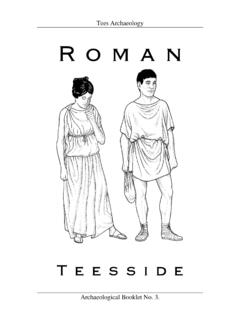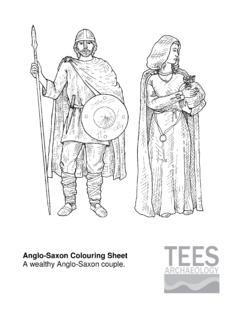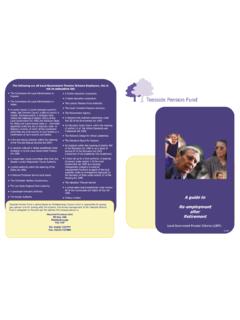Transcription of Tees Archaeology AngloAnglo- ---SaxonSaxonSaxon
1 Tees Archaeology Archaeological Booklet No. 1. AngloAngloAngloAnglo----SaxonSaxonSaxonS axon TeessideTeessideTeessideTeesside Anglo-Saxon name-stone from Church Close, Hartlepool. Front cover: An Anglo-Saxon Brooch from Norton. Text prepared by Peter Rowe, Tees Archaeology 2000. First Printing August 2000 (1000 copies) Anglo-Saxon teesside Contents 1 Who were the Saxons? 1-2 2 Settlements 3-5 3 Cemeteries 6-11 4 Men 12-15 5 Women 16-21 6 Technology 22-26 7 Trade 27 8 Religion 28-29 9 The end of Saxon England 30-31 Further Reading Inside back cover Anglo-Saxon teesside 1 1 Who were the Saxons? The Anglo-Saxons invaded Britain from Germanic Europe in the 5th century AD. Britain was part of the Roman Empire at this time.
2 The Germanic invasion of Britain The Venerable Bede who wrote the first history of England in the 8th century tells us that these Germanic invaders were 'Angles', 'Saxons' and 'Jutes'. The Jutes settled in the south-east, in Kent and the Isle of Wight. The Saxons mostly in the midlands with the Angles heading up the north-east coast to areas such as teesside . Anglo-Saxon teesside 2 The Romans erected defences against the Anglo-Saxon raiders. They built Signal Stations along the south and east coast to warn against attacks. There was a signal station at Saltburn. It was one of a line on the Yorkshire coast with others at Goldsborough, Ravenscar, Scarborough and Filey. A Roman Signal Station Unfortunately the signal station at Saltburn has disappeared as the cliff on which it stands has eroded away.
3 Luckily part of the site was excavated in 1910 before it completely vanished. Amongst the finds was a stone well that included the remains of 14 people who may have died defending the site against invasion. The bones included men and women and both the young and old. After 400 AD the Romans left Britain and the Anglo-Saxons began to raid and settle in greater numbers. Anglo-Saxon teesside 3 2 Settlements Most Anglo-Saxons lived in small communities or isolated farms. There were few towns of any size. A Saxon 'village' consisted of several single-roomed buildings. These were grouped together around a large hall or meeting house where the family would have lived, eaten and slept. An Anglo-Saxon settlement Buildings would have been timber-framed, probably infilled with wattle panels daubed with clay to make them weatherproof.
4 Anglo-Saxon settlement sites are hard to find as very little survives. Archaeological excavation can detect the differently Anglo-Saxon teesside 4 coloured soil fills of post-holes and trenches left by rectangular buildings and fenced enclosures. An excavated building at Hartlepool Excavations at Hartlepool recovered the plans of 16 Anglo-Saxon buildings. These were all quite small measuring on average x metres. The houses would have been 2 metres high with thatched roofs. Place names Saxon settlements can be detected by place-names. Anglo-Saxon names traditionally end in the letters 'ton' as in Marton, 'ham' as in Newham or 'ley' as in Hunley. Other Anglo-Saxon names are descriptive and describe the appearance of a settlement.
5 Examples are Acklam which means 'place of oaks', Yarm which may refer to a 'salmon fishery' and Redmarshall which means 'reed marsh'. Later Viking place names end in the letters 'by' as in Ingleby and 'thorpe' as in Pinchinthorpe. Anglo-Saxon teesside 5 Anglo-Saxon and Scandinavian place names Anglo-Saxon teesside 6 3 Cemeteries The Anglo-Saxons buried their dead in cemeteries. Cemeteries have been excavated at Saltburn and Norton. Elsewhere, such as at Maltby and Brierton, individual burials have been found. Saxon grave goods from Maltby (front and side views) Saxon burials are often easy to identify because the dead were buried with personal possessions including jewellery and weapons. As Pagans the Anglo-Saxons believed these objects might have been useful in the afterlife.
6 The excavation of cemeteries tells us a great deal about the lives of the Anglo-Saxons. We can begin to reconstruct their dress and appearance, learn about their technologies, religion, and way of life. Anglo-Saxon teesside 7 Hob Hill, Saltburn The earliest evidence of Anglo-Saxons in the Tees area was found at Hob Hill, near Saltburn. The cemetery was discovered in 1909 by miners quarrying for ironstone. William Hornsby, a local man, found that the cemetery contained 48 burials. Much of the material was recorded and collected as the workmen uncovered it. Finds from Hob Hill, Saltburn The finds from the cemetery include bead necklaces, pottery vessels, brooches, a spearhead and a throwing axe.
7 Many of the burials at Hob Hill were cremations placed in urns. Anglo-Saxon teesside 8 Mill Lane, Norton In 1982 an Anglo-Saxon burial was discovered at Norton. The burial was found accidentally by children who had hung a rope-swing from a tree on the embankment above Mill Lane. As the children swung on the rope their feet constantly scuffed the ground creating a hollow which revealed a shallow grave. The grave was that of a young woman aged between 25 and 35 years old. The woman's personal possessions were buried with her and included a brooch and glass and amber beads. These finds date to the 5th and 6th centuries AD. Archaeological excavation revealed that the burial was part of a much larger cemetery. The cemetery was excavated over a period of two years and contained 120 burials.
8 Male and female burials were roughly equal in number at the cemetery. People originally thought that the cemetery might represent a war grave. If this were the case we would expect more male burials than females. The equal numbers suggests that the cemetery served a normal population. The cemetery was situated in an area marked out by ditches. The ditches were actually Roman field boundaries that the Norton Saxons later used to define their cemetery. The graves were laid out in rows aligned north to south. This is typical of Pagan burial sites whereas Christian burials are aligned east to west. Anglo-Saxon teesside 9 Reconstruction of Norton cemetery Anglo-Saxon teesside 10 There were four main types of burial at the Norton cemetery: - 1 Extended burial - This was the most common type of burial.
9 The bodies were placed in the grave, stretched out and lying on their backs. 2 Crouched burial - This type of burial was less common with the people placed on their sides as if they were asleep. Anglo-Saxon teesside 11 3 Prone burials - These facedown burials are very interesting. The bodies were thrown headfirst in to the grave with their hands and feet tied together. These people may have been buried alive as a punishment for cowardice or witchcraft. 4 Cremated burials - Cremations were rare at the site. The cremated remains were all placed in small urns. One of the urns had been placed in a pit on top of some animal bones. It contained the remains of two people, an adult and a teenager. Anglo-Saxon teesside 12 4 Men The Saxons were buried with their clothing and personal possessions.
10 Men were commonly buried with their weapons including shields and spears. Warrior burial The man above was buried at Norton with a wide range of artifacts including a shield, a seax (sword) and a spearhead. A Saxon shield was a small defensive weapon used to deflect an opponents attack. The shields were made of wood and covered in leather with a central iron fitting known as a boss. Anglo-Saxon teesside 13 Iron Seax The seax was a small single edged iron sword. This was the only example found at Norton. Iron Spear The spear was the basic weapon of an adult free man. The spearhead was made of iron with a shaft of wood. Anglo-Saxon teesside 14 The amount of weaponry in a grave denotes its status. Graves of the lowest rank had a single weapon.








